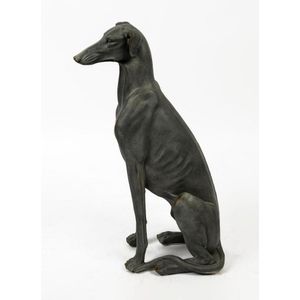
20th Century Greyhound Statue with Metallic Finish, 77 cm High
A greyhound statue, chalk ware with metallic finish, 20th century, 77 cm high, 32 cm deep

"Fruit Boy" Chalk Ware Card Holder - Early 20th Century
'Fruit Boy' figural card holder, painted chalk ware, early 20th century, 53 cm high
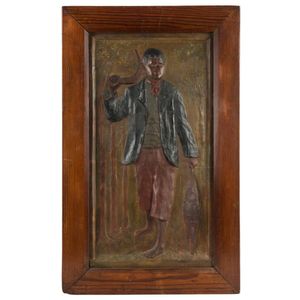
Aboriginal Chalk Ware Plaque in Pine Frame
An Australian painted chalk ware plaque of an Aborigine in red pine frame, late 19th century 84 x 50 cm overall. Provenance: The John Stephens Collection

Australian Aborigine Boy with Koala Statue
An Australian painted chalk ware statue of an Aborigine boy with koala, mid 20th century, 17 cm high

Early 20th Century Kookaburra Chalk Statue from Greenberg Collection
'Kookaburra' statue, painted chalk ware, early 20th century, 26 cm high. Provenance: The Joseph Greenberg collection

"Fruit Boy" Chalk Ware Card Holder
'Fruit Boy' calling card holder, painted chalk ware, early to mid 20th century, 76 cm high

Gold Lady Art Deco Statue - 39cm Height
Art Deco chalk ware figural statue of a lady, painted in gold, height 39 cm.

Bronzed Male Nude Statue by Charles G. Williams (1943)
Charles G. Williams, chalk ware statue of a male nude with bronzed finish, signed and dated 1943, 26 cm high

Chalkware Kookaburra Statue, Late 20th Century, 27 cm High
A kookaburra statue, painted chalk ware, late 20th century, 27 cm high

Aboriginal Bust by Harold English
Harold English, bust of an Aboriginal man, painted chalk ware, signed 'Harold English, 1969', 15 cm high
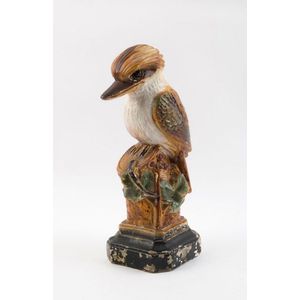
1920s Kookaburra Chalk Ware Statue
'Happy Jack', kookaburra statue, painted chalk ware, circa 1920s, 38 cm high

Mid-century Kookaburra Chalkware Statue, 26cm
A kookaburra statue, painted chalk ware, early to mid 20th century, 26 cm high

Early 20th Century Kookaburra Chalk Statue, 26cm High
'Kookaburra' statue, painted chalk ware, early 20th century, 26 cm high

Chalk Ware Figural Group by Triaka & Co
A Continental chalk ware figural group, signed 'Triaka & Co.', late 19th century, 48 cm high

Elegant Berlin Chalk Statue, Late 19th Century
'Elegante Berlinoise' painted chalk ware statue, late 19th century, 30 cm high

1920s Bathing Beauty Chalk Statue
A chalk ware statue of a bathing beauty, circa 1920, 28 cm high, 46 cm long

Art Nouveau Water Carrier Statues
Pair of Art Nouveau chalkware statues of the water carriers, circa 1900, the larger 23.5 cm high

American Chalk Statue: Nude Female, 20th Century
An American chalk ware statue of a female nude, 20th century, 77 cm high

Art Deco Chalk Ware Statue, 1930s, 43x70cm
An Art Deco chalk ware statue, circa 1930s, 43 cm high, 70 cm wide
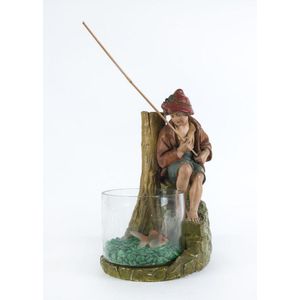
Antique Fishing Boy Statue with Fishbowl
A Continental chalk ware fishing boy statue with glass fishbowl, circa 1900, 46 cm high

Victorian Chalkware Relief Carved Bust in Circular Frame
A framed Victorian Chalkware relief carved bust, late 19th/Early 20th century, the relief carving portrait, depicting a young female, housed in a circular frame. The frame 40 cm diameter

Napoleonic Chalk Ware Statues, Late 19th/Early 20th Century
A pair of Napoleonic style chalk ware statues with hand painted finish, late 19th/early 20th century, 98 cm high
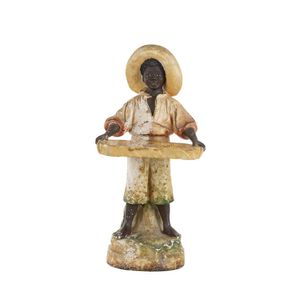
Early 20th Century Fruit Boy Chalk Statue - 52cm
Fruit Boy' chalk ware statue, early 20th century, 52 cm high

Greek Male Nude Statue, 19th Century
A classical Greek statue of a male nude, painted chalk ware, late 19th century, 74 cm high

Plains Indian Chalkware Bust, Early 20th Century
A painted chalkware bust of a native American plains Indian, early 20th century, 54 cm high,

Sir Henry Parkes Bust and Book
Sir Henry Parkes bust and book. Fragmentary Thoughts, Sir Henry Parkes, pub by S E Lees, Sydney 1889. Gift inscription from Parkes to Hugh Taylor. Also chalkware bust signed Allom, height 25 cm (bust)

Gilded Art Deco Dancer Figure (with losses)
An Art Deco gilded chalkware figure of a dancer, 38 cm high (some losses to paint work)

Art Nouveau Female Bust, Depose Inscription, 65cm High
A French Art Nouveau chalk ware female bust, inscribed' Depose' to base, some losses, 65 cm high

Hand Painted Parrot Chalkware Statues, Early 20th Century
A pair of chalkware hand painted parrot statues, early 20th century, 28 cm high

Middle Eastern Couple Chalkware Busts by Universal Statuary Co
A pair of painted chalkware busts of a Middle Eastern couple, impressed 'Universal Statuary Co. Chicago 1954', 19 cm high

Antique Middle Eastern Relief Panels
A pair of antique Chalkware relief panels. Late 19th to early 20th century. The large plaques dramatically framed with palm trees and draped curtains depicting exotic Middle Eastern scenes: a figure of a woman upon a horse, and a man upon a camel holding…

Esther Hunt Butterfly Chalkware Bust
An Esther Hunt chalkware bust of 'Butterfly', circa 1930s, the handpainted and moulded figure of a young Asian girl with a wistful gaze attired in a Prussian blue and floral robe and a jewelled and floral cloche; inscribed signature verso and painted name…
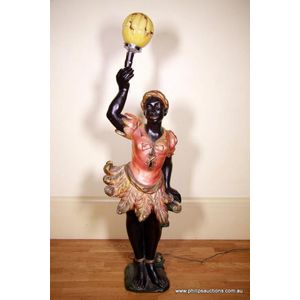
Exotic Blackamoor Floor Lantern with Art Deco Glass Shade
A Chalkware female blackamoor floor lantern, circa 1930-1940s, the exotic figure dressed in a flouncy leafy skirt, a puff sleeved blouse and a turban, her right arm raised and holding an Art Deco amber and tan glass ball shade; upon an integral base and…



 Loading more...
Loading more...